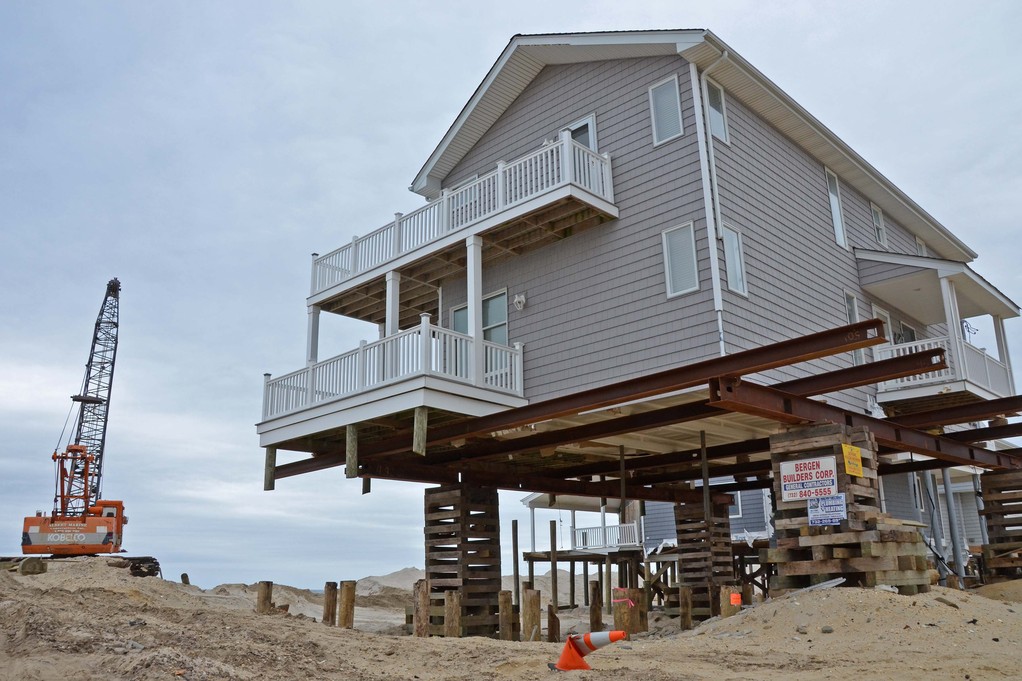A new working paper from the Congressional Budget Office estimates that for every dollar spent to elevate or buy-out a flooded home, $2.69 would be saved in future costs over the next 30 years. Of the 1.3 million projects the paper identifies, roughly 138,000 would see a greater savings of $6 dollars. Total savings would amount to $519 billion in future damage if governments and homeowners together would spend $193 billion today.
Former Florida Deputy Insurance Commissioner Lisa Miller sat down with one of the paper’s co-authors and the head of a national home floodproofing solutions company to discuss the government’s current efforts – and what’s lacking – to avoid costly future flood damage across the nation.

Evan Herrnstadt, Economist, Congressional Budget Office

Tom Little, President & CEO, Floodproofing.com
Show Notes
The Congressional Budget Office (CBO) is the research arm of the U.S. Congress, tasked with providing nonpartisan analysis for lawmakers to consider when making policy. Its May 2024 working paper, Flood Damage Avoided by Potential Spending on Property-Level Adaptations found:
-
- There are opportunities for adaptation for approximately 1.3 million projects nationwide (each adapting a single property of one to four units) where the expected avoided damage exceeds project costs primarily from elevating the home above flood stage or a buyout of the property for later destruction.
- The total cost of completing these projects would be $193 billion, preventing $519 billion of expected damage over 30 years.
- On average, each dollar spent on these projects would avoid $2.69 of expected damage.
- About 138,000 projects would result in expected avoided damage over six times the cost of the project.
- Outcomes vary based on area income and geography.
“We started looking into federal spending on adaptation to flood risk and we found that there’s a big literature out there, but it can be really difficult to compare across studies, and apply one context to another,” explained paper co-author Evan Herrnstadt. “So we would need a scalable and flexible approach and found it was feasible for us to use the National Structure Inventory from the U.S. Army Corps of Engineers and flood modeling from the First Street Foundation and combine that with some other work to estimate avoided damage from property level interventions like buyouts and elevations,” said Herrnstadt, who is a CBO economist. The national framework that CBO developed used inland and coastal residential properties that contain 1 to 4 housing units.
While the CBO doesn’t make policy recommendations to Congress, Herrnstadt said in this report, it does characterize sets of projects and different allocation schemes to provides potential opportunities to avoid flood damage paid principally by federal, state, and local governments, together with homeowners. The paper notes that FEMA has multiple programs that fund property-level adaptation. From fiscal years 2008 to 2019, annual obligations for those programs totaled about $280 million, representing an average of 29% of the amount FEMA has obligated for hazard mitigation.

A home in Ortley Beach, N.J. is elevated to mitigate and adapt to growing flood risk from storm surge after Hurricane Sandy, April 13, 2013. Courtesy, Sharon Karr/FEMA
“Evan this is fantastic work,” said Tom Little, President & CEO of Floodproofing.com, an integrated company providing property risk analysis, wet and dry floodproofing solutions, and flood insurance. “This is the type of information that we need to get out there to continue to build awareness that we can actually invest money and get a strong return on that investment, by retrofitting the existing infrastructure that we have,” said Little, who is a Certified Floodplain Manager and also Vice Chair of the Flood Mitigation Industry Association. “I know that you focused on residential, but the same rules apply, or the same analysis would apply to non-residential on our commercial structures and really lines up with findings from the National Institute of Building Science.”
Host Miller noted this sort of mitigation is especially needed in Florida, which is surrounded by water on three sides and prone to hurricanes and other tropical events, such as the recent wave of thunderstorms that brought 20+ inches of rain to Miami-Dade and Broward counties from June 11-13, 2024, just prior to the podcast recording.
“If your driver’s license says Florida, you should have flood insurance. If it rains, it can flood,” warned Miller. “We see so much flooding, not only in coastal areas, but inland from hurricanes Ian and Nicole just two years ago, and we’re still cleaning that up. And homeowners have frankly struggled to repair or rebuild.” She said mitigation that better adapts homes to flood risk will lead to lower insurance costs, too.
The National Flood Insurance Program (NFIP) paid out $913 million in claims last year, with $629 million of that going to Florida residents for major flooding from past hurricanes and storm surges. Florida has the largest concentration of NFIP policyholders with 1.7 million of the total 4.7 million policies nationwide.
“If we can get in there and elevate the structure, that’s always the best to get that home high and dry,” said Little. “Lisa, to tie this back to insurance, we can dramatically reduce the NFIP, but also the private carriers that are in the market, we can reduce exposure dramatically.”
Little said there are other alternative mitigation measures beyond elevation that reduce flood risk. They include so-called wet floodproofing, which involves relieving hydrostatic pressure on the structure’s foundation through the use of vents or breakaway walls, to allow water to come in and go back out, preserving the foundation. Another method is dry floodproofing, which uses physical barriers that instead of relieving pressure off the walls actually resist the water from coming into the structure. The CBO paper noted that the NFIP does not grant insurance premium reductions for dry floodproofing, nor does it allow substantially damaged or substantially improved properties to be dry floodproofed.
“They do talk about it in the non-residential space quite a bit in their literature, but we’re modeling residential areas,” explained Herrnstadt. “And then on top of that, just the historical funding of disaster mitigation programs through FEMA have not funded much residential flood proofing at all, which reflects this. And so that’s why our main analysis only has elevations and buyouts in it,” he said.
Herrnstadt said the CBO paper does have an additional scenario looking at dry floodproofing for homes that have appropriate attributes. “We did find that you could provide protection to a large number of properties for which the avoided damage outweighs the cost,” he said. The CBO is expected to release another report soon, titled Flood Insurance in Communities at Risk of Flooding.
Links and Resources Mentioned in this Episode
Flood Damage Avoided by Potential Spending on Property-Level Adaptations (Congressional Budget Office, May 2024)
Homeowner’s Guide to Retrofitting: Six Ways to Protect Your Home From Flooding (FEMA, December 2009)
Flood Insurance & Reslience (Lisa Miller & Associates)
Private Primary Residential Flood Insurance Model Act (National Council of Insurance Legislators)
Congressional Budget Office (CBO) Working Papers & Reports
Subscribe to the LMA Newsletter (free)
** The Listener Call-In Line for your recorded questions and comments to air in future episodes is 850-388-8002 or you may send email to [email protected] **
The Florida Insurance Roundup from Lisa Miller & Associates, brings you the latest developments in Property & Casualty, Healthcare, Workers’ Compensation, and Surplus Lines insurance from around the Sunshine State. Based in the state capital of Tallahassee, Lisa Miller & Associates provides its clients with focused, intelligent, and cost conscious solutions to their business development, government consulting, and public relations needs. On the web at www.LisaMillerAssociates.com or call 850-222-1041. Your questions, comments, and suggestions are welcome! Date of Recording 6/14/2024. Email via [email protected] Composer: www.TeleDirections.com © Copyright 2017-2024 Lisa Miller & Associates, All Rights Reserved


